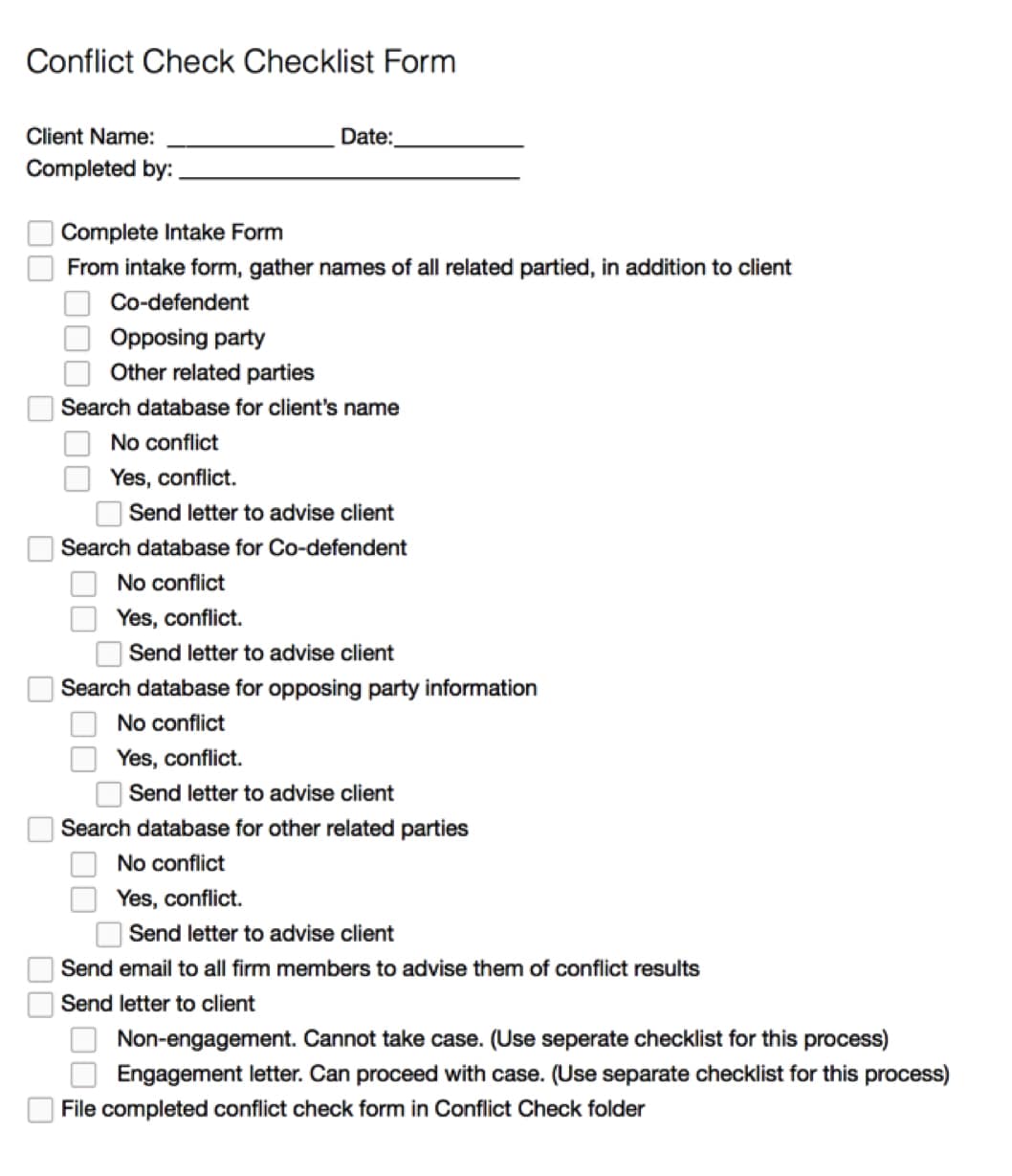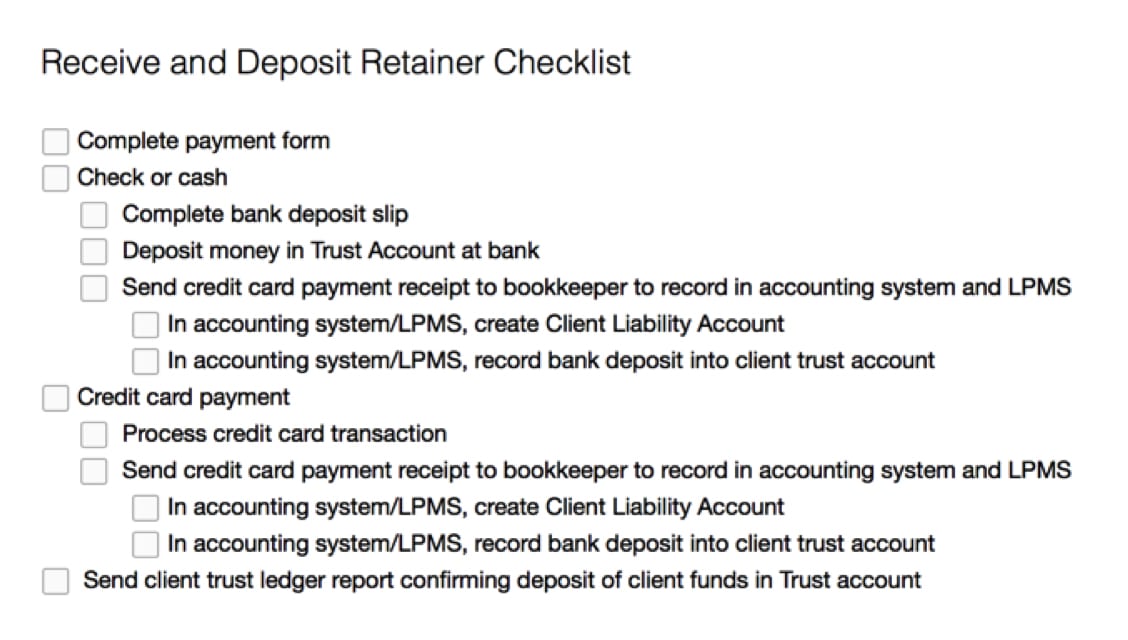Creating law firm checklists for routine processes saves time and helps you avoid mistakes. Here are five types of checklists to get you started.

Key Takeaways
- Checklists: Checklists are key in a law firm to increase efficiency and reduce errors. They help legal professionals to organise and manage routine tasks so all steps are followed correctly.
- Document Management System (DMS): A DMS is a game changer for law firms. It manages legal documents so they are easily accessible and secure. A DMS also helps with client document retention rules and overall productivity.
- Better Client Experience: Document management and checklists = client satisfaction. By keeping client documents retained and managed correctly, law firms can show they are professional and reliable and get repeat business.
Processes are the means by which we get things done, and checklists can keep us on top of what needs to get done. That’s why pilots, surgeons and astronauts use checklists extensively. They help eliminate the fear of forgetting something important.
When you set up a new client file, end a client matter or do any number of common law practice tasks, you have a standard process. Many of these processes are likely in your head, though, and not well documented. Law firm checklists are great tools for making sure you are completing these routine processes without mistakes. Checklists also save you time, especially if you want to delegate tasks within your legal teams.
So let’s get some of these processes out of your head and onto paper (or perhaps digital paper).
Five Law Firm Checklists to Get You Started
1. Checking Conflicts
To effectively analyze conflicts, you need to have a conflict-checking procedure. Some jurisdictions require law firms to maintain a conflict-checking system and to have a policy in place. But absent that requirement, I think setting up a simple conflict-checking checklist, and documenting that you used it, is a sufficient process. Even in very small or solo firms, you should never rely on your memory to determine whether you have a conflict. Detecting a conflict after the representation has started may harm the client and your reputation. Plus, it creates extra work — like having to refund that retainer payment you already deposited.
Here is a sample checklist created using Evernote. Of course, you could add more details, such as the location of the files to be searched, whether you search open as well as closed files, and what will be searched: emails, document server, contact database and so on.

2. Setting up a Client File
Setting up new client files is time-consuming. So grab your pencil and start writing down step by step how you do it. Flesh it out, edit it and rewrite it until you have created a checklist that’s clear and easy to follow. That way, you’ll be ready to delegate the administrative aspects of the task as soon as you can afford to do so.
3. Receiving a Retainer
Every lawyer knows that mismanaging a trust account (IOLTA) can have terrible consequences. Creating a checklist to ensure you are properly depositing a retainer is a good idea to avoid missteps. For the below checklist, the goal is to make sure you are processing the initial receipt of retainer correctly. (Note: LPMS stands for Law Practice Management System.) In “Would You Pass a Trust Account?” I review the trust accounting process in more detail.

4. Doing Month-End Accounting
Following a month-end checklist keeps your eyes on the business side of your practice. Some of the steps to include are:
- Make sure all monthly expenses and payments received have been recorded.
- Reconcile operating and trust accounts.
- Sign off on reconciled reports (especially trust accounts if you have delegated this task to someone else).
- Review key financial and performance metrics, including:
- Monthly and YTD profit and loss reports
- Past-due invoices
- IOLTA balances by client
- Number of new clients or matters this month
- Update your cash-flow analysis spreadsheet.
- If profits are up, consider giving yourself a raise!
5. Closing a Matter
There are rules you need to follow and things you’ll want to do when closing a matter. Creating a checklist of those steps will keep you in compliance with client document retention rules. Your list may include these items:
- Advise clients their case is complete and inform them of any next steps they will need to take.
- Retain client documents for the time period required in your jurisdiction.
- Return original documents to the client.
- Ask for referrals and repeat business. (You might also ask your client to leave a review on one of your online profile sites.)
- Remind clients of any outstanding balances and your procedures for payment.
Bonus: The Advantages of Creating Law Firm Checklists
Creating law firm checklists have many benefits that can significantly enhance your practice. Here are some:
- Improved Efficiency: Checklists simplify processes so tasks are done right and on time. Less chance of mistakes and omissions.
- Increased Productivity: By following a checklist, legal professionals can ensure that all necessary steps are taken, leading to more efficient task completion and better time management.
- Better Organization: Checklists keep the firm organized. All documents and files are managed properly so they are easier to find and retrieve.
- Reduced Risk: Checklists reduce the risk of misplacing or losing important documents. This is key to client trust and helps comply with legal requirements.
- Enhanced Client Satisfaction: Properly managed and retained client documents means better client satisfaction. Clients like the professionalism and reliability that comes with good document management.
For Even More Law Firm Efficiency: Implement a Document Management System
Implementing a Document Management System (DMS) is a total game changer for law firms wanting to increase efficiency and productivity. A DMS helps manage legal documents seamlessly so you can find and access them when you need to. Here’s how to get started:
- Document Types: Start by categorizing the types of documents your firm deals with, contracts, pleadings, briefs, motions etc. This will help you to organize and manage them.
- Security Levels: Determine the level of security required for each document type. Sensitive documents may require higher security to protect client confidentiality.
- Choose the Right DMS: Choose a DMS designed for the legal industry that meets your firm’s needs. Look for search, security and integration with other software.
- Train Authorized Users: Make sure all authorized users are trained on how to use the DMS. This will ensure consistency and accuracy in document management.
- Document Management Policy: Create a policy that outlines the procedures for indexing, storing and retrieving documents. This will ensure all documents are managed and searchable.
- Backups and Archives: Back up and archive documents to protect them and keep them available. This is critical for disaster recovery and long term document retention.
By using a DMS law firms can simplify document management, reduce the risk and increase productivity.
Efficient Document Management
Efficient document management is important for law firms to minimize the risk of losing or mismanaging documents. Here are some practical tips to help manage your documents:
- Utilize a DMS: Rely on a Document Management System rather than physical storage or basic cloud storage. A DMS offers advanced features tailored for managing legal documents.
- Implement Retention and Disposal Policies: Set clear policies for document retention and disposal. So documents are kept for the right amount of time and disposed of when no longer needed.
- Leverage Digital Tools: Use practice management software and document management software to manage and store documents. They have features that make life easier and more organized.
- Ensure Proper Indexing: Make sure all documents are indexed and searchable. So you can find and access documents when you need to, faster and with less hassle.
- Regularly Review Procedures: Review and update your document management procedures regularly so they stay relevant and efficient. So you can adapt to new challenges and improve processes.
Law firm checklists and document management are key to a successful law firm. By having a law firm checklist and Document Management Systems and following good document management practices, law firms can reduce the risk of losing or mismanaging important documents. And creating and using checklists can increase efficiency, productivity, organization and client experience. By following these tips, law firms can have secure, accessible and managed documents and a more profitable law practice.
Image © iStockPhoto.com.

Sign up for Attorney at Work’s daily practice tips newsletter here and subscribe to our podcast, Attorney at Work Today.















